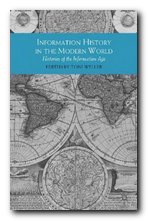studies in data design 1750-2010
There’s a general tendency to believe that ours is pre-eminently the Age of Information. We speak of ‘information overload’, ‘data glut’, ‘digital anxiety’ and use various other metaphors of being overwhelmed by the sheer volume of knowledge, facts, and statistics at our disposal. But in fact information history has been around ever since people began making records and storing the results, even if those were marks on clay tablets. The difference is that we now have more immediate access to it, from a multiplicity of sources.
 This collection of academic essays seeks to put down markers and make a contribution to a growing field of study – ‘the histories of information’. The use of the plural indicates that there is no single theory of the development of informatics, and ‘the Modern World’ in the book’s title should be taken as indicating the period from 1750 to the present. The individual studies cover an amazing range of topics and disciplines. They begin for instance with the recording of personal identity in public information systems. That is, the official data that tells you who a person actually is. The sources range from parish registers, lists of vagrants and householders, birth and marriage certificates, to the advent of ID numbers – which have still not found favour in the UK.
This collection of academic essays seeks to put down markers and make a contribution to a growing field of study – ‘the histories of information’. The use of the plural indicates that there is no single theory of the development of informatics, and ‘the Modern World’ in the book’s title should be taken as indicating the period from 1750 to the present. The individual studies cover an amazing range of topics and disciplines. They begin for instance with the recording of personal identity in public information systems. That is, the official data that tells you who a person actually is. The sources range from parish registers, lists of vagrants and householders, birth and marriage certificates, to the advent of ID numbers – which have still not found favour in the UK.
Many of the heroes of this pre-history were librarians, and there are sketches of the early information architects, including the seventeenth century figure of Théophraste Renaudot. Starting from an impulse to record the unemployed poor, he assembled what was an early form of labour exchange which also doubled as a pawn shop, a citizen’s advice bureau, and a publishing house for the Gazette de France – a combination of weekly newspaper and eBay.
There’s also a chapter on the design and completion of official government census and tax return forms which is (if you can believe it) almost amusing. First because of the appalling layout of the documents and the demands they made of people who might well have been illiterate and innumerate. Second because the understandable response of the recipients is to scribble illegibly, omit information, or give contradictory answers.
Other chapters include studies of the Imperial Institute (an empire of information) and the company staff magazine (information as paternalistic control). Although this young discipline is so far dominated by work done in the UK, the studies stretch themselves geographically to cover Denmark and Uganda.
The collection ends with a very theoretical examination of the notion of history itself, taking a view that in the digital age we cannot know the past because the ‘narratives’ by which we explore it in digital texts become too ephemeral. Like many other heavily theoretical arguments, this one does not bother stooping to examine any concrete examples but contents itself with a series of generalizations linked by mention of the most fashionable surnames in the genre of critical theory – from Baudrillard and Barthes to Eagleton, Derrida, and Foucault
This is something of a let-down after the fascinating studies which precede it. But like most theoretical writing of its kind, it will undoubtedly fade rapidly into oblivion, leaving the real life, hard work, concretely researched studies to speak for themselves. The study of information history might still be in its infancy (according to these authors) but with approaches as diverse as the best illustrated here it seems to be in safe hands.
© Roy Johnson 2011
Toni Weller (ed), Information History in the Modern World, London: Palgrave Macmillan, 2011, pp.211, ISBN: 0230237371
More on information design
More on design
More on media
More on web design